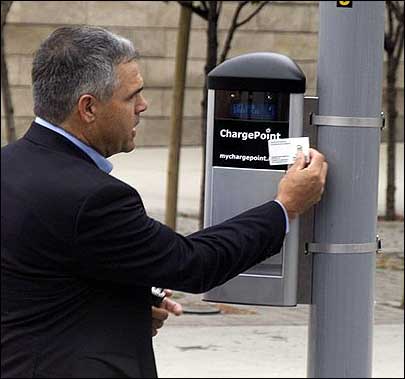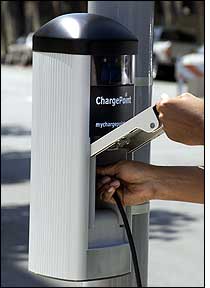Next month, Coulomb Technologies, a Campbell, Calif., startup company, says it will begin installing networked stations that drivers of electric vehicles can use to charge up their cars’ batteries in the event that they lack access to a home garage, or are in need of a charge while at work or running errands. To get the power flowing, drivers—who will subscribe for either pay-as-you-go or monthly unlimited access to the stations—will employ RFID-based ID cards or key fobs.
Coulomb plans to install several of its Smartlet charging stations in San Jose, Calif., by the end of this year. Standalone versions of the stations are a little larger than a parking meter, the company indicates; smaller models can be mounted on a pole or wall, and be located on city streets.

Subscribers to the service will be issued their own RFID card or fob containing a high-frequency passive RFID inlay compliant with the ISO 15693 standard. To begin recharging their cars’ batteries, subscribers will simply hold their card or fob up to an RFID interrogator embedded in the Smartlet unit. Tom Tormey, the company’s VP of product management, says the RF signal between the card and reader will be encrypted to secure the ID number transmitted by the card.
A 2.4 GHz ZigBee transceiver, compliant with the IEEE 802.15.4 standard and built into each charging station, will pass the captured data along from one charging station to the next until it reaches the nearest ZigBee gateway (each can support up to 100 charging stations), which will then pass that information to a central server over a General Packet Radio Service (GPRS) radio modem. Coulomb software running on that server will determine whether the card’s ID number is valid and its account is current, Tormey says—and, if so, it will send back an authorization for the charging station to initiate a charge. This process, he notes, will all happen in real time.
According to Tormey, the firm decided to utilize RFID cards and fobs for their ease of use, and because they will offer a bridge to being able to let drivers use an RFID-enabled credit or debit card—a function the company plans to begin offering sometime in the future. (The RFID cards issued by Visa, MasterCard and other businesses comply with the ISO 13444 air-interface standard, though Tormey says the readers the company will install will be able to read these as well.) “We think RFID offers the best user experience,” Tormey states.
Although there are few electric cars presently on U.S. roads, a large percentage, according to Tormey, can be found in the San Francisco Bay area, which includes San Jose. What’s more, he adds, area automotive shops that convert gasoline cars to electric vehicles are fully booked up and unable to meet demand, while sales are up for low-speed, limited-range electric cars designed for city errand-running, such as those manufactured by Zap.
But what Coulomb is really focused on are the all-electric and hybrid electric models that major automakers such as GM (Chevy Volt), BMW (Mini) and Volvo plan to begin selling over the next couple of years. By 2013, up to 20 percent of cars on U.S. roads could be electric. Since studies indicate 40 percent of consumers who say they would purchase an electric car have no access to a garage for overnight charging, and because even those with a garage will sometimes need to charge up their cars while away from home, Coulomb figures that up to 8 million charging stations will be required nationwide.The company does not believe it will be able to meet that demand on its own, however. Other startups, such as Palo Alto-based Better Place, are already beginning to build charging stations. It’s vital, Tormey asserts, that these competing providers start developing common standards so drivers of electric vehicles can patronize charging stations from different providers—he likens this to the fact that when traveling, consumers can use their cell phones by “roaming” onto various cell networks. Agreeing to a common RFID standard, he notes, will ensure that drivers with Coulomb accounts will be able to drive up to a competitor’s charging station and still use the same card to access the outlet at that site—though to do so, he says, they may need to pay an additional amount, similar to a phone’s roaming fee.

Tormey says he is currently working with another charging-station startup, the name of which he declines to disclose, to develop an RFID application standard based on the ISO 15693 standard. U.K. startup firm Elektromotive is already issuing the cards to users of its 21 charging stations in and around London, he says.
In the United States, subscribers will be able to use a Google maps application—which they’ll be able to access on their home computer, or on a Web-enabled phone—to locate the nearest Coulomb charging station. (When each new charging station is installed, its GPS coordinates will be uploaded to the Google maps application.) Beginning in January 2009, they’ll also be able to log on to Coulomb’s customer site, Mychargepoint.net, to manage their accounts, or to suggest a new charging station.
Coulomb’s business model is similar, in other ways, to that of cellular phone service providers, Tormey says. What the company will provide is an infrastructure of charging stations, as well as a means by which drivers will be able to access and pay for electricity. To select sites and install the charging stations, Coulomb is working with municipalities and the utility provider in each town where it plans to install the stations. The firm is selling its charging stations to the municipalities or private companies that own the real estate—parking lots or curbsides, for instance—where the electric vehicles will be placed
Utility companies are concerned that high demand for electricity to power cars could cause a drain on their electrical grids. Therefore, Tormey says, Coulomb will offer special “grid-friendly” pricing plans, whereby drivers will agree to have their access to charging stations denied during periods of peak power usage, in exchange for a lower access fee.
Last month, Coulomb announced its partnership with Gilbarco Veeder-Root, a provider of payment systems for gasoline stations, including modules that can read RFID inlays embedded in contactless credit cards. The companies indicate they are working together to build out the charging station infrastructure, but have not yet provided details regarding exactly which products or services Gilbarco Veeder-Root will deliver.

